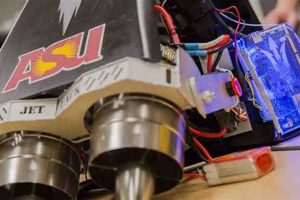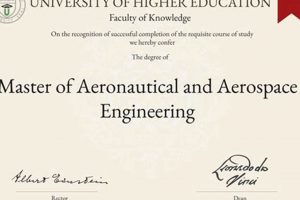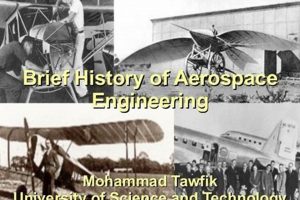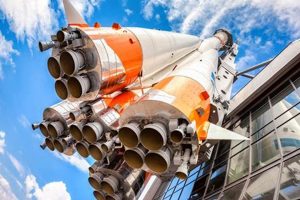Aerospace engineering at the National Aeronautics and Space Administration (NASA) involves the design, development, testing, and implementation of aircraft and spacecraft. Individuals in this role contribute to projects ranging from advanced aircraft concepts to deep-space exploration missions. This career path represents a pinnacle for many aspiring engineers due to the complex challenges and potential for groundbreaking advancements.
The significance of this profession lies in its direct impact on scientific discovery, technological innovation, and national prestige. NASA’s aerospace engineers have historically played pivotal roles in landmark achievements, including the Apollo missions, the development of the Space Shuttle, and the ongoing exploration of Mars. The pursuit of advancements in aeronautics and astronautics directly benefits society through technological spin-offs and a deeper understanding of the universe.
Achieving a position in this field requires a specific combination of education, skills, and experience. The following sections will detail the necessary academic qualifications, essential skills, and strategic approaches to securing a career as an aerospace engineer within the agency.
Strategies for Pursuing a Career in Aerospace Engineering at NASA
The following strategies offer practical guidance for individuals aspiring to positions as aerospace engineers within the National Aeronautics and Space Administration (NASA). Adherence to these guidelines enhances the likelihood of a successful application and career trajectory.
Tip 1: Cultivate a Strong Academic Foundation: A Bachelor’s degree in Aerospace Engineering, or a closely related field such as Mechanical Engineering with a focus on aerospace, is paramount. Coursework should include advanced mathematics, physics, aerodynamics, propulsion, and control systems.
Tip 2: Pursue Advanced Education: A Master’s or Doctoral degree can significantly enhance competitiveness. Advanced degrees allow for specialization in areas of specific interest to NASA, such as hypersonics, advanced materials, or space systems engineering.
Tip 3: Gain Relevant Internship Experience: Internships at NASA, aerospace companies (e.g., Boeing, Lockheed Martin), or research institutions are invaluable. These experiences provide practical application of theoretical knowledge and exposure to real-world engineering challenges.
Tip 4: Develop Specialized Skills: Proficiency in computer-aided design (CAD) software (e.g., CATIA, SolidWorks), computational fluid dynamics (CFD) software (e.g., ANSYS Fluent), and programming languages (e.g., MATLAB, Python) is highly desirable. Knowledge of specific aerospace systems is beneficial.
Tip 5: Focus on Research and Publications: Participating in research projects and publishing findings in peer-reviewed journals demonstrates a commitment to advancing the field and enhances credibility. Research should align with NASA’s strategic goals and areas of interest.
Tip 6: Network Strategically: Attend industry conferences, career fairs, and networking events. Connect with NASA engineers and researchers to learn about career opportunities and gain insights into the agency’s culture and priorities. Professional organizations like AIAA are valuable resources.
Tip 7: Highlight Leadership and Teamwork Skills: NASA projects often require collaboration across diverse teams. Demonstrating leadership capabilities through extracurricular activities, team projects, or volunteer experiences is crucial. Strong communication and interpersonal skills are essential.
Successful implementation of these strategies significantly increases the probability of securing a position. These steps cultivate the necessary expertise and experience to excel in this demanding and rewarding field.
The subsequent section will address the final considerations in this career journey.
1. Education
The attainment of a rigorous educational foundation constitutes a fundamental prerequisite for pursuing a career at the National Aeronautics and Space Administration (NASA) as an aerospace engineer. The academic pathway undertaken directly influences an individual’s competence in addressing the complex engineering challenges inherent in NASA’s missions. A Bachelor’s degree in Aerospace Engineering, or a closely aligned field such as Mechanical Engineering with a concentration in aeronautics or astronautics, serves as the entry point. This undergraduate education provides the essential theoretical knowledge in areas such as aerodynamics, propulsion, structures, and control systems. Without this baseline of academic training, the practical application of engineering principles within NASA’s demanding environment becomes significantly hindered.
Furthermore, the pursuit of advanced degrees, such as a Master’s or Doctoral degree, often becomes a differentiating factor in securing competitive positions. These advanced studies allow for specialization in niche areas relevant to NASA’s strategic goals, such as hypersonic flight, advanced materials, or space systems design. For instance, an engineer with a Master’s degree specializing in computational fluid dynamics may be better equipped to contribute to the design and analysis of advanced aircraft or spacecraft. Similarly, research conducted during doctoral studies provides a valuable foundation for contributing to NASA’s research and development efforts. The lack of advanced education can limit an engineer’s ability to contribute to cutting-edge research and development initiatives within the agency.
In summary, education is not merely a prerequisite but rather an indispensable component of the qualification profile for a career at NASA as an aerospace engineer. It is a pivotal factor that determines the extent to which an individual can contribute to NASA’s mission of exploration and scientific discovery. While practical experience gained through internships is valuable, the underlying theoretical framework acquired through formal education enables engineers to effectively apply their knowledge to real-world problems and contribute to innovative solutions.
2. Experience
Practical experience serves as a cornerstone in the trajectory toward becoming an aerospace engineer at the National Aeronautics and Space Administration (NASA). The theoretical knowledge acquired through academic pursuits gains tangible relevance through application in real-world scenarios. The absence of pertinent experience frequently diminishes a candidate’s competitiveness, irrespective of academic credentials. For instance, an engineer with a perfect GPA but no hands-on involvement in aerospace-related projects may struggle to effectively contribute to NASA’s complex missions.
Internships at NASA facilities, aerospace companies, or research institutions provide invaluable exposure to the intricacies of aerospace engineering. These experiences allow individuals to apply their knowledge to practical problems, work within multidisciplinary teams, and gain familiarity with industry-standard tools and processes. Participation in research projects, whether as an undergraduate or graduate student, offers opportunities to develop specialized skills and contribute to the advancement of the field. Furthermore, involvement in engineering clubs or student organizations, such as those focused on rocketry or unmanned aerial vehicles, demonstrates a commitment to the field and provides opportunities for hands-on learning. A candidate who has designed, built, and tested a rocket as part of a student project showcases practical skills and a passion for aerospace that extends beyond the classroom.
In summary, experience acts as the bridge connecting theoretical knowledge to practical application. It allows aspiring NASA aerospace engineers to develop the skills, problem-solving abilities, and teamwork capabilities necessary to contribute to the agency’s ambitious missions. While education lays the foundation, experience reinforces and expands upon that foundation, transforming academic knowledge into actionable expertise. Therefore, the strategic pursuit of relevant experience is indispensable for any individual seeking to become an aerospace engineer at NASA.
3. Skills
The requisite skills for prospective aerospace engineers at the National Aeronautics and Space Administration (NASA) represent a crucial determinant of success. These capabilities, honed through education, experience, and continuous learning, enable engineers to contribute effectively to NASA’s multifaceted projects. A lack of essential skills can significantly impede an individual’s ability to perform effectively within the agency’s demanding environment.
- Proficiency in Computer-Aided Design (CAD) Software
Expertise in CAD software, such as CATIA, SolidWorks, or NX, is indispensable for designing and modeling aerospace components and systems. These tools allow engineers to create detailed 3D models, perform simulations, and generate manufacturing drawings. For instance, engineers utilize CAD software to design aircraft wings, spacecraft structures, and propulsion systems. Competence in CAD software directly impacts the efficiency and accuracy of the design process.
- Competence in Computational Fluid Dynamics (CFD) Software
CFD software, including ANSYS Fluent or OpenFOAM, enables engineers to simulate fluid flow around aerospace vehicles and components. This capability is critical for analyzing aerodynamic performance, optimizing designs for reduced drag, and predicting thermal behavior. Engineers employ CFD software to assess the performance of aircraft wings at various speeds or to model the heat transfer characteristics of spacecraft during reentry. Proficient CFD skills contribute to enhanced design optimization and performance prediction.
- Programming and Scripting Skills
Programming languages such as Python, MATLAB, and C++ are essential for developing simulations, analyzing data, and automating engineering tasks. Engineers use these languages to create custom tools for data processing, develop control algorithms, and perform complex calculations. For example, an engineer may write a Python script to analyze flight data or develop a MATLAB simulation of a spacecraft’s trajectory. Robust programming skills facilitate efficient data analysis and the development of custom engineering solutions.
- Knowledge of Aerospace Materials and Manufacturing Processes
A comprehensive understanding of aerospace materials, such as aluminum alloys, composites, and titanium, is crucial for selecting appropriate materials for specific applications. Furthermore, familiarity with manufacturing processes, including machining, welding, and additive manufacturing, is necessary for designing parts that can be effectively produced. For instance, an engineer must understand the properties of carbon fiber composites and the process of composite layup to design a lightweight and strong aircraft structure. This knowledge ensures designs are both functional and manufacturable.
The confluence of these skills, augmented by specialized knowledge relevant to specific NASA projects, significantly enhances an engineer’s ability to contribute meaningfully to the agency’s mission. While academic credentials and practical experience provide a foundation, mastery of these specific skills translates directly into tangible contributions to the design, analysis, and implementation of NASA’s complex and ambitious projects. For example, a deep understanding of control systems theory coupled with proficiency in MATLAB enables an engineer to develop advanced guidance and control algorithms for spacecraft. Therefore, the cultivation of relevant skills is paramount for any individual aspiring to a career as an aerospace engineer at NASA.
4. Research
Research constitutes an integral component of the qualifications for aerospace engineers at the National Aeronautics and Space Administration (NASA). The capacity to conduct, analyze, and apply research findings is critical for contributing to the agency’s mission of exploration, scientific discovery, and technological innovation. The following aspects delineate the connection between research and achieving a career as an aerospace engineer at NASA.
- Contribution to Scientific Advancement
Active engagement in research, whether through academic projects or independent studies, enables engineers to contribute to the advancement of aerospace knowledge. Participation in research exposes engineers to cutting-edge technologies, novel methodologies, and unsolved problems within the field. For example, conducting research on advanced propulsion systems or novel materials for spacecraft construction allows engineers to develop expertise in areas directly relevant to NASA’s mission. A demonstrated ability to contribute to scientific advancements enhances an applicant’s competitiveness.
- Development of Analytical Skills
Research inherently demands the development of strong analytical and problem-solving skills. Engineers engaged in research learn to formulate hypotheses, design experiments, collect and analyze data, and draw conclusions based on evidence. These analytical skills are crucial for addressing the complex engineering challenges encountered at NASA, such as designing efficient spacecraft trajectories, optimizing aerodynamic performance, or troubleshooting system failures. Possessing robust analytical skills is essential for effective problem-solving and decision-making.
- Demonstration of Initiative and Self-Direction
Undertaking research projects often requires significant initiative and self-direction. Engineers must be able to independently identify research opportunities, formulate research questions, develop research plans, and execute those plans effectively. This demonstration of initiative and self-direction is highly valued at NASA, where engineers are often tasked with working independently on complex projects with minimal supervision. A proven track record of self-directed research demonstrates a candidate’s ability to take ownership of projects and drive them to completion.
- Publication and Dissemination of Findings
The publication of research findings in peer-reviewed journals or conference proceedings is a critical step in disseminating new knowledge to the scientific community. Publishing research demonstrates an engineer’s ability to communicate complex technical information effectively and to contribute to the collective knowledge base of the field. This skill is particularly valuable at NASA, where engineers are often required to present their findings to colleagues, stakeholders, and the public. A publication record enhances an applicant’s credibility and demonstrates a commitment to advancing the field.
In summary, research plays a pivotal role in shaping the qualifications of aerospace engineers at NASA. Active participation in research fosters scientific advancement, develops analytical skills, demonstrates initiative, and facilitates the dissemination of knowledge. These qualities are essential for contributing to NASA’s mission of exploration and scientific discovery. The cultivation of research experience significantly enhances an aspiring engineer’s prospects of securing a fulfilling and impactful career at NASA.
5. Networking
Networking plays a crucial role in gaining entry into the National Aeronautics and Space Administration (NASA) as an aerospace engineer. Building professional connections increases awareness of available opportunities and provides access to insider information regarding the agency’s priorities and hiring processes. The competitive nature of positions within NASA necessitates proactive engagement with professionals already established in the field. Attending industry conferences, seminars, and workshops allows aspiring engineers to interact with NASA personnel, learn about ongoing projects, and understand the specific skill sets valued by the agency. For example, attending the American Institute of Aeronautics and Astronautics (AIAA) SciTech Forum could provide opportunities to meet NASA engineers and researchers.
Informational interviews with individuals currently working at NASA offer valuable insights into the agency’s culture, expectations, and career paths. These conversations can reveal unadvertised job openings and provide guidance on tailoring resumes and cover letters to align with NASA’s specific needs. Furthermore, networking extends beyond formal events. Engaging with NASA engineers on professional platforms like LinkedIn and participating in online aerospace engineering communities can create opportunities for informal mentorship and knowledge sharing. Actively participating in these online communities allows individuals to showcase their expertise and build relationships with professionals in the field.
Effective networking, therefore, is not merely about collecting contacts but about building meaningful relationships with professionals who can provide guidance, support, and opportunities. It requires consistent effort, genuine interest, and a proactive approach. Establishing a strong professional network significantly increases an individual’s visibility and competitiveness in the pursuit of a career as an aerospace engineer at NASA. Challenges include overcoming initial reluctance to approach established professionals and maintaining consistent engagement with contacts over time. However, the potential rewards of a robust network far outweigh these challenges, solidifying networking as an indispensable component in navigating the path to NASA.
6. Leadership
Leadership capabilities are highly valued attributes for aerospace engineers at the National Aeronautics and Space Administration (NASA). The agency’s complex and collaborative projects necessitate engineers who can effectively guide teams, manage resources, and inspire innovation. Demonstrated leadership potential enhances an individual’s prospects for advancement and contribution to NASA’s mission.
- Team Leadership and Collaboration
NASA projects often involve diverse teams of engineers, scientists, and technicians. Leadership in this context requires the ability to foster collaboration, resolve conflicts, and guide the team towards a common goal. For instance, leading a team tasked with designing a new spacecraft component necessitates effective communication, delegation of tasks, and the ability to integrate diverse perspectives. Successful team leadership ensures efficient project execution and fosters a positive working environment.
- Project Management Skills
Aerospace engineers frequently assume project management responsibilities, overseeing budgets, timelines, and resource allocation. Leadership in project management entails the ability to define project objectives, develop realistic schedules, mitigate risks, and ensure that projects are completed on time and within budget. The project manager for the James Webb Space Telescope, for example, had to demonstrate exceptional leadership skills to manage a complex project with numerous stakeholders and technical challenges. Effective project management is crucial for the successful completion of NASA’s ambitious endeavors.
- Technical Expertise and Mentorship
Leadership also encompasses technical expertise and the ability to mentor junior engineers. Senior engineers often serve as mentors, providing guidance, sharing knowledge, and fostering the professional development of their colleagues. Technical leadership requires a deep understanding of engineering principles and the ability to communicate complex concepts clearly. Mentoring junior engineers not only develops their skills but also contributes to the long-term success of the agency.
- Strategic Vision and Innovation
Leadership at NASA extends beyond day-to-day project management and encompasses strategic vision and the ability to drive innovation. Engineers who can identify emerging trends, propose novel solutions, and champion new technologies are highly valued. The development of new propulsion systems or the design of innovative spacecraft concepts requires engineers with a visionary outlook and the ability to inspire others to embrace change. Strategic leadership ensures that NASA remains at the forefront of aerospace technology and continues to push the boundaries of exploration.
These leadership facets, when combined with technical proficiency and a commitment to excellence, are essential for aerospace engineers at NASA. Demonstrating leadership capabilities through academic projects, extracurricular activities, and professional experiences significantly enhances an individual’s competitiveness and potential for success within the agency. Therefore, cultivating leadership skills is a strategic investment for aspiring NASA engineers.
Frequently Asked Questions
The following addresses common inquiries regarding the pursuit of a career as an aerospace engineer within the National Aeronautics and Space Administration (NASA). These responses aim to provide clear and concise information to assist prospective applicants.
Question 1: What is the minimum educational requirement?
A Bachelor’s degree in Aerospace Engineering or a closely related field, such as Mechanical Engineering with a specialization in aerospace, is generally considered the minimum requirement. However, many positions, especially those involving research and development, often favor candidates with advanced degrees.
Question 2: How important are internships in securing a position?
Internships are highly valuable. Practical experience gained through internships at NASA, aerospace companies, or related research institutions significantly enhances a candidate’s competitiveness by providing hands-on experience and exposure to real-world engineering challenges.
Question 3: Which skills are most sought after by NASA in aerospace engineering candidates?
Proficiency in Computer-Aided Design (CAD) software, Computational Fluid Dynamics (CFD) software, and programming languages like MATLAB and Python are highly desirable. Strong analytical and problem-solving skills are also critical, as is a solid understanding of aerospace materials and manufacturing processes.
Question 4: Does prior research experience play a significant role in the selection process?
Yes, participation in research projects and the publication of research findings in peer-reviewed journals or conferences is highly beneficial. It demonstrates a commitment to advancing the field and enhances credibility.
Question 5: How important is networking with NASA professionals?
Networking is a valuable strategy. Attending industry events, connecting with NASA engineers on professional platforms, and participating in aerospace engineering communities can increase awareness of opportunities and provide insights into the agency’s priorities.
Question 6: Are leadership skills considered essential for aerospace engineers at NASA?
Leadership skills are increasingly important, particularly as engineers advance in their careers. The ability to lead teams, manage projects, and inspire innovation is highly valued, especially in collaborative and multidisciplinary projects.
These FAQs provide a condensed overview of the key factors influencing the path to becoming an aerospace engineer within NASA. A comprehensive understanding of these elements is crucial for effectively navigating the application and selection process.
The subsequent and final section will summarize this article’s key element.
How to Be an Aerospace Engineer at NASA
The pursuit of a career path focused on how to be an aerospace engineer at nasa requires strategic planning and dedicated execution. The path encompasses rigorous academic preparation, hands-on experience, proficiency in relevant technical skills, demonstrable research contributions, proactive networking within the aerospace community, and cultivation of leadership abilities. Each element contributes critically to a candidate’s competitiveness in a field characterized by intense competition and stringent selection criteria. Mastering these areas provides a solid foundation for a potentially transformative journey.
The information presented throughout this exploration of how to be an aerospace engineer at nasa is designed to equip aspiring professionals with the knowledge and insights necessary to navigate this challenging yet rewarding career trajectory. Diligent application of these principles can significantly enhance the probability of achieving the goal of contributing to the agency’s future endeavors in space exploration, scientific discovery, and technological advancement. The future of aerospace engineering innovation may depend on the informed actions taken today.







